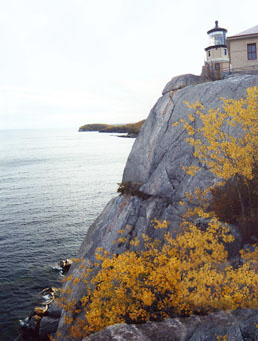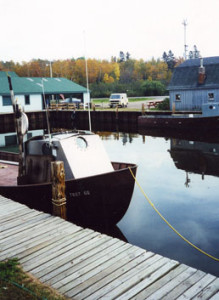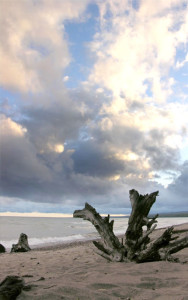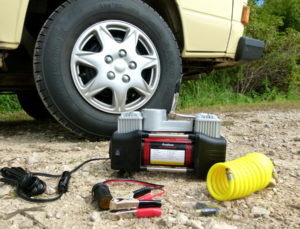Day 6 Grand Marais, Minnesota
Our wake-up call this morning comes courtesy of Jake, genius boy-inventor of the noisy “Jake Brake”, standard equipment on the rumbling logging trucks on the highway just outside our front door. We arise early and have breakfast in a cafe overlooking the small harbor, and see no sign of the Grand Marais—or Big Swamp.
 Before hitting the road, we stop at a convenience store for road snacks. It’s a briskly cold morning, so when Lorie goes inside I turn on the Westy’s seldom used diesel-fueled auxiliary heater to warm things up while I check the Westy’s tire pressures. Lorie returns with Twinkies and chocolate milk just in time to find the van, and me, engulfed in white smoke clouds of cumulonimbus proportions. I quickly reach inside the cab to switch off the heater, and when I emerge from the swirling billows of smoke I see Lorie halted, petrified, a safe distance away while other patrons nervously duck or crouch warily behind their vehicles. I finally manage to coax Lorie into the van, and I cheerfully wave and motor away, leaving behind only a lingering odor and some bewildered townsfolk.
Before hitting the road, we stop at a convenience store for road snacks. It’s a briskly cold morning, so when Lorie goes inside I turn on the Westy’s seldom used diesel-fueled auxiliary heater to warm things up while I check the Westy’s tire pressures. Lorie returns with Twinkies and chocolate milk just in time to find the van, and me, engulfed in white smoke clouds of cumulonimbus proportions. I quickly reach inside the cab to switch off the heater, and when I emerge from the swirling billows of smoke I see Lorie halted, petrified, a safe distance away while other patrons nervously duck or crouch warily behind their vehicles. I finally manage to coax Lorie into the van, and I cheerfully wave and motor away, leaving behind only a lingering odor and some bewildered townsfolk.
We follow the historic Gunflint Trail out of Grand Marais, up into the wild country of extreme northeast Minnesota. Probably first blazed by Archaic native peoples more than 5,000 years ago, the Gunflint was later used as a trade route by Ojibwe, Voyageurs, and fur trappers. Even today it is one of the primary gateways to the backcountry of the Boundary Waters Canoe Area, a remote region along the Canadian border boasting probably half of Minnesota’s famed 10,000 lakes. Ancient pictographs can still be found on rock faces and cliffs along the lakes in this region, and trapping and trading flourished here through the 19th century.

Laurentian Divide: “Water at this point flows northward into Canada’s Hudson Bay watershed and eastward into the Saint Lawrence watershed.”
Hundreds of hikers and paddlers were camped in the Boundary Waters, and even those with weather radios had nowhere to hide when the powerful straightline winds blasted into their camps. Search-and-rescue floatplanes and helicopters spent days evacuating the injured. Despite the awesome destruction, the Wilderness Area has begun its recovery, with new areas opened up to deer and wolf populations, and young seedlings already struggling upward among the fallen bodies of their parents.
Rejoining Hwy 61, we continue northward and cross into Canada just north of Grand Portage, MN, then drive nearly to Thunder Bay, Ontario. It is almost dark when we arrive at Kakabeka Falls Provincial Park and camp for the night.

 In the morning we make a short sidetrip south of the city of Superior to Pattison State Park, where we find Wisconsin’s highest waterfall, and the fourth highest east of the Rockies. At 165 feet, the waterfall was called Big Manitou by the native Ojibwa, who heard the voice of the Great Spirit in the bellowing and crashing waters of the Black River. At the base of the falls is a steep-walled gorge carved over the past 10,000 years. In the fall, chinook salmon swim several miles upstream from Lake Superior to the base of Big Manitou to spawn.
In the morning we make a short sidetrip south of the city of Superior to Pattison State Park, where we find Wisconsin’s highest waterfall, and the fourth highest east of the Rockies. At 165 feet, the waterfall was called Big Manitou by the native Ojibwa, who heard the voice of the Great Spirit in the bellowing and crashing waters of the Black River. At the base of the falls is a steep-walled gorge carved over the past 10,000 years. In the fall, chinook salmon swim several miles upstream from Lake Superior to the base of Big Manitou to spawn.



 But as we approach, he stirs and sits up, blinking at his surroundings in great confusion and gazing dumbfounded at the blazing orange ball rising in the sky, as if seeing it for the very first time. It seems as though he is not from this world. I recall the mysterious shimmering lights I saw in the sky last night, and wonder if perhaps he is some wayward humanoid alien, a galactic traveller cast off on this distant terrestrial shore by his mutinous shipmates. I hope he doesn’t want to bum a ride; if he is accustomed to interstellar travel, he will be duly disappointed with the speed of the diesel Vanagon, which is barely inter-state …
But as we approach, he stirs and sits up, blinking at his surroundings in great confusion and gazing dumbfounded at the blazing orange ball rising in the sky, as if seeing it for the very first time. It seems as though he is not from this world. I recall the mysterious shimmering lights I saw in the sky last night, and wonder if perhaps he is some wayward humanoid alien, a galactic traveller cast off on this distant terrestrial shore by his mutinous shipmates. I hope he doesn’t want to bum a ride; if he is accustomed to interstellar travel, he will be duly disappointed with the speed of the diesel Vanagon, which is barely inter-state … Arriving back in LaPointe we board the ferry to return to the mainland. The streets of Bayfield are quiet this morning, the Apple Festival revelers evidently sated and sleeping off the effects of yesterday’s apple orgy. We motor northward on Hwy 13 and pass through the tiny hamlet of Cornucopia, Wisconsin’s northernmost town. After enjoying lunch in a lakeside picnic ground here we visit the used bookstore and walk the tiny historic waterfront. Quaint, charming, and the whole place smells of fish. We rejoin Route 2 and continue westward to Amnicon Falls State Park.
Arriving back in LaPointe we board the ferry to return to the mainland. The streets of Bayfield are quiet this morning, the Apple Festival revelers evidently sated and sleeping off the effects of yesterday’s apple orgy. We motor northward on Hwy 13 and pass through the tiny hamlet of Cornucopia, Wisconsin’s northernmost town. After enjoying lunch in a lakeside picnic ground here we visit the used bookstore and walk the tiny historic waterfront. Quaint, charming, and the whole place smells of fish. We rejoin Route 2 and continue westward to Amnicon Falls State Park.
 Bayfield is now considered the gateway to the Apostle Islands archipelago. Set aside by Congress as a National Scenic Lakeshore in 1970, the twenty-two islands which make up the Apostles offer a glimpse into a distant and pristine natural history visible in few other places. The layers of precambrian sandstone which once formed the ancient seabed here have now been uplifted and eroded by wind and water to form islands with beautiful and intricate cliff formations, spires, and sea caves. Due to their remoteness, and preservation by the Lighthouse Service, several of the islands still bear their ancient old-growth forests, and all are home to a diverse population of nesting and migratory birds and a variety of other wildlife.
Bayfield is now considered the gateway to the Apostle Islands archipelago. Set aside by Congress as a National Scenic Lakeshore in 1970, the twenty-two islands which make up the Apostles offer a glimpse into a distant and pristine natural history visible in few other places. The layers of precambrian sandstone which once formed the ancient seabed here have now been uplifted and eroded by wind and water to form islands with beautiful and intricate cliff formations, spires, and sea caves. Due to their remoteness, and preservation by the Lighthouse Service, several of the islands still bear their ancient old-growth forests, and all are home to a diverse population of nesting and migratory birds and a variety of other wildlife. Our brief voyage across the waters of the bay soon brings us to Madeline Island, where we disembark at the tiny village of LaPointe. At just fourteen miles long and three wide, Madeline is the largest of the twenty-two islands making up the Apostles, and the only inhabited one. According to Ojibwa oral tradition, the people used to inhabit the Atlantic coast of North America. A shaman had a prophetic vision informing him that a race of fair-skinned invaders was coming soon to destroy them, and instructing the people to leave their homeland and migrate westward to a preordained island: “the place of the turtle”. Most of the Ojibwa clans heeded this warning and embarked on the centuries-long voyage up the St. Lawrence, struggling for survival against the strange lands and the war-like tribes they encountered along the way. Indeed, the single clan that stayed behind to greet the arriving Europeans were virtually wiped out by epidemics of smallpox, measles, and tuberculosis.
Our brief voyage across the waters of the bay soon brings us to Madeline Island, where we disembark at the tiny village of LaPointe. At just fourteen miles long and three wide, Madeline is the largest of the twenty-two islands making up the Apostles, and the only inhabited one. According to Ojibwa oral tradition, the people used to inhabit the Atlantic coast of North America. A shaman had a prophetic vision informing him that a race of fair-skinned invaders was coming soon to destroy them, and instructing the people to leave their homeland and migrate westward to a preordained island: “the place of the turtle”. Most of the Ojibwa clans heeded this warning and embarked on the centuries-long voyage up the St. Lawrence, struggling for survival against the strange lands and the war-like tribes they encountered along the way. Indeed, the single clan that stayed behind to greet the arriving Europeans were virtually wiped out by epidemics of smallpox, measles, and tuberculosis.










